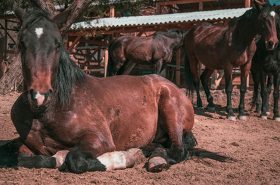Summer is the season when equine ear issues tend to arise, many caused by biting insects. Your horse may show a sudden aversion to having their head or ears touched, or there may be visible signs of trauma to the inside of the ears.
Below, you’ll find the most common equine ear issues and tips for dealing with them:
Aural Plaques
Aural plaques, also known as ear papillomas, are raised, pinkish bumps or patches that develop on the inner ear. They are caused by the papillomavirus, which is most likely transmitted by black flies. Often, both ears are affected and the horse may show discomfort.
Aural plaques can be treated with consistent use of fly repellent and protecting the ears with a fly mask. Stabling during dawn and dusk, when black flies are most active, is also helpful.
Ear Ticks
Ticks can attach themselves anywhere on the horse, but they are commonly found in the ears. The ear tick infests and lives on the external ear canal. A horse with ear ticks may show signs of headshaking, head rubbing, or have droopy ears.
To treat ear ticks, consider both the animal and the environment. Remove as many ticks as possible with tweezers and use topical insecticides. If the horse has developed a bacterial or yeast infection due to tick infestation, your veterinarian can recommend treatment.
Fly Strike

Fly strike is most often caused by stable flies, black flies, and biting midges. The bites lead to small, round bumps and raised, reddened areas with central bloody crusts in the ears.
Treatment for fly strike includes use of fly repellents, controlling the fly population with environmental cleanup such as manure management, and environmental insecticides. Wounds in the ears can be treated with a topical wound dressing.
Sarcoids
Sarcoids are skin masses that can appear in various locations on the horse’s body. However, they often develop at the base, edge, or inside of the pinna of the ear. Sarcoids are rough, often raised masses that may stall small for long periods of time. However, they can grow and multiply, and may even bleed.
If the sarcoids are small and don’t appear to be causing a problem, you can leave them alone. They may even go away eventually. However, if they are causing discomfort for the horse, treatment often involves surgical removal with a laser or injectable topical chemotherapy.



